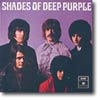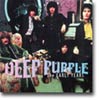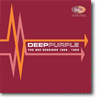| |
||||
|
In the short period of time in which they were together, Deep Purple's first line-up released a relative avalanche of albums and singles. The first of each brought considerable success in the USA, a success which dimmed as the band sought to escape their unwelcome labelling as a transatlantic pop act.
The story of the formation of Deep Purple is a tangle of coincidences, nebulous ideas and raw enthusiasm, with the central aim of putting together a band which would immediately be ready to take on the world. The beginning of the thread came from one Chris Curtis. In 1967 he carried around the fantasy of building a group centred around himself in his old Searchers role as both drummer and lead singer. His previous track record impressed businessmen Tony Edwards and John Coletta, who agreed to finance and manage the new group, which at that time existed only in Curtis' imagination. Their investment would eventually pay off beyond their wildest dreams, but that would be largely due to the incredible musical chemistry between the first two musicians enrolled into the plan: organist Jon Lord and guitarist Ritchie Blackmore. First brought together in December 1967, they quickly hit upon one of the most unique and universally loved 'sounds' in rock music. Even after Curtis' ideas had inevitably nosedived into the realms of unrealisable fantasy and he had drifted from the picture, Edwards and Coletta had no hesitation in backing a group built around Lord and Blackmore. The line-up was quickly completed with experienced ex-Johnny Kidd & The Pirates bassist Nick Simper, plus singer Rod Evans and drummer Ian Paice, both from The Maze. Once the band was finalised in March 1968, there was no hanging around, a debut tour followed in April (during which 'Deep Purple' was chosen to replace original name 'Roundabout'), and a first album was hurriedly recorded over a single weekend in May.
What's often taken for granted about Deep Purple Mk 1 is that inside nine months they recorded three studio albums and a non-album single... prolific isn't the word. Those early releases have been described as lacking direction. In reality the band were still coming to grips with a wonderful new sound which seemed to work with virtually any type of music, and which did not limit them to a set direction. Every musical avenue was open, and the first to bring success was pop. Debut single 'Hush' was a huge US hit, climbing into the Billboard top five. Soon afterwards their very aptly titled first album 'Shades Of Deep Purple' was scaling the album charts. There was hardly a pause for breath. A major American tour was booked for October 1968, and second album 'The Book Of Taliesyn' was recorded and rush released to coincide. It followed the same basic formula as the first; a mix of Vanilla Fudge style covers (ie. expanded, slowed down and steamrollered), classical interludes, and self-written pieces packed with every musical idea that could be shoehorned in. However, the music had become more uncompromising. It was developing an edge at odds with their unwelcome pigeon-holing as a pop act. Follow-up singles 'Kentucky Woman' and 'River Deep, Mountain High' still did reasonably well however, indeed Purple's 'River Deep..' outperformed the classic Ike & Tina Turner version in the US charts. When US sales began to slide (a non album single 'Emmaretta' went nowhere fast in early 1969) so did the reasoning to keep the band as it was. Despite carrying a wide spectrum of interesting and intricate music, their third album (the eponymous 'Deep Purple'), was not the way forward, and the line up that recorded it was history by the time of release in July. In May 1969 Paice, Lord and Blackmore decided to take the plunge and concentrate on the increasingly dominant hard rock and classical elements in their music, leaving behind the pop and commercial side, and aiming at the UK and European rock circuit. Some of the earlier album material lent itself well to the superb improvised instrumental skills of the musicians, but new, dynamic songs were also needed. Simper and Evans, now seen as being unsuited to the band, were to be replaced. The split was not as straightforward as it could have been, both Simper and Evans were kept uninformed as long as possible. Even after their replacements Ian Gillan and Roger Glover (from Episode Six) had already been enlisted and begun recording and rehearsing with the band, Simper and Evans remained in the dark, and continued to play live with the band for some time. Neither was pleased at eventually hearing of their impending fate through the musicians' grapevine. Evans ended up forming the excellent US based Captain Beyond with ex-members of Iron Butterfly, while Simper formed Warhorse, a UK based rock band who tried to follow in the vapour trail of Deep Purple Mk 2. |
|||||||||||||||||||||||||||||||||||||||||||||||
.... 1968-1969 Deep Purple Mk 1 UK Discography ....
|
|||||||||||||||||||||||||||||||||||||||||||||||
.... Deep Purple Mk 1 On Video / DVD....
Very little Mk1 footage has come to light. The 2009 'History, Hits & Highlights' collection includes most of an October 1968 live performance on the Playboy After Dark TV show ('Hush' plus a shortened version of 'And The Address'), a mime to 'Help' from Danish TV in May 1968, and a live in the studio clip of 'Wring That Neck'. |
....Deep Purple Mk 1, Further Reading....
|
Deep
Purple Mk 1 at www.deep-purple.net |
Deep
Purple Mk 1 at www.deep-purple.net...contd |


















